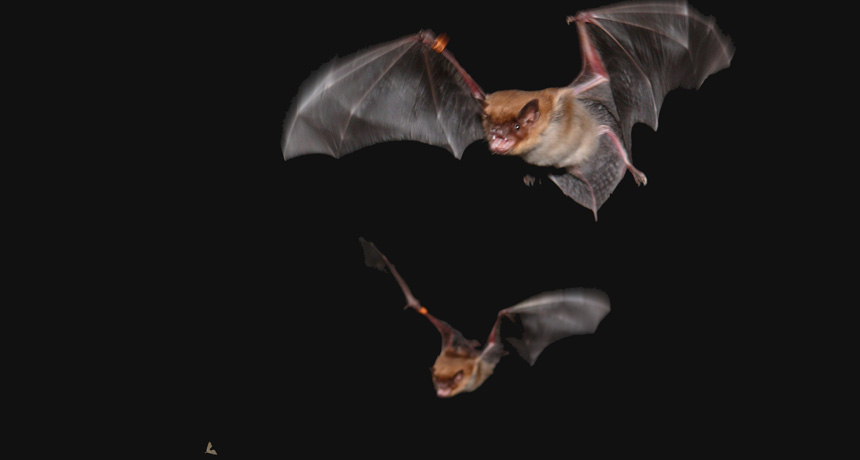Bats’ dinner conversation may go over your head
Male big brown bats use ultrasonic sounds to tell others to back off

When male big brown bats have to compete for a single insect, they make sounds to signal to others, “get away from my dinner.”
Jessica Nelson
- More than 2 years ago
On summer evenings in North America, entire conversations go on above your head. Mixed in with the evening birdcalls and droning of insects, there are calls just beyond the range of our pathetic human ears: the vocalizations of bats. We usually think of bats as preternaturally quiet, but it turns out that when these little insect eaters stealthily swoop through the night, they aren’t silent at all.
Scientists at the University of Maryland have shown that when male big brown bats (Eptesicus fuscus) compete for food, the loudest bat gets the worm. These big boy bats produce calls that warn other bats away from their meal. The vocalizations are entirely unlike the noises bats produce to echolocate, and suggest that there is an entire dialogue taking place above us that we have only recently recognized.
A big brown bat is not the leathery monster you might picture. About 10 centimeters (four inches) long and weighing a bit less than a fun-size Snickers, these bats have a wingspan of about 30 centimeters (one foot). They snap up insects over most of North America and have a tendency to end up in our attics. They hunt via echolocation, producing ultrasonic pulses that the bats use to detect prey.
Genevieve Spanjer Wright and her colleagues at the University of Maryland were interested in whether bats might also emit sounds to communicate. In a previous study, the group reported that bats make what appear to be six different types of social calls. Some appeared to be associated with times when the bats were foraging for food. But it’s very hard to tell in the wild what chirp belongs to which bat. “There’s a huge amount of stuff that we don’t know yet because of the problem of observing and tracking bats outdoors,” says James Simmons, a neuroscientist at Brown University in Providence, R.I.
To find out more, Wright’s group flew captive bats (obtained when someone puts in a panicked call about a bat in their attic) in pairs in a large arena, with a single helpless mealworm tethered to the floor. The two-bats-one-bait scenario produced a competitive situation. It was also a tough task, as bats aren’t used to attacking a tethered meal. Bats exposed to the arena for the first time flew hungrily and helplessly — and silently.
But when bats had been trained to pick up the tethered mealworm, the situation changed. In results published March 27 in Current Biology, Wright and her colleagues showed that experienced bats began to emit a series of calls called frequency-modulated bouts, or FMBs, three to four pulses followed by a “feeding buzz.” These were longer and lower in frequency than the pulses that big brown bats use for echolocation. The sounds were highly individual, and the scientists were easily able to trace them to a particular bat.
When two experienced bats faced off against each other, the most gregarious bat frequently took home the worm. When bats emitted the FMBs, the other bat would back off.
Wright and her colleagues hypothesize that these calls are ways to lay claim to food, and perhaps to territory as well. Wright says that she and other scientists have “anecdotal records of some bats chasing other bats away,” and Simmons notes that his group has recorded bats engaging in “dogfights.” But further studies will have to tell how often and why FMBs might be used in the wild. Brock Fenton, a bat behaviorist at the University of Western Ontario in Canada, wants to see if playing FMBs in the wild alters natural bat behavior. “It’s a fascinating discovery,” he says, “because it shows us that these calls are happening, so people can be alert for it. It gives us the ability to try the field experiment.”
Strangely, only male bats appear to battle it out with their vocalizations. Female bats flown against each other in the arena flew silently. Because female bats are more likely to associate together and forage near each other, Wright suggests that they might behave in a more cooperative manner. But scientists still need to figure out whether this always holds true. “The piece that’s missing is that there will be female bats flying around with the males,” Simmons explains. “What do female bats do when other bats are around?”
Gareth Jones, an evolutionary biologist at the University of Bristol in England, notes that without this laboratory study, scientists may never have been able to grasp the function of the vocalizations at all. “Figuring out vocalizations in the wild is very difficult,” he says. “You can’t tell whether your bat is male or female, old or young. So by doing this study in the lab, Wright could examine both the calls themselves and how the bats responded.”
Big brown bats are incredibly common, but scientists are only now learning how they communicate with each other. “This species has been very well studied in terms of echolocation, but there have only been a handful of papers on their social calls,” Wright says. “There’s a rich vocal repertoire for these species that is just beginning to be understood.” But this study demonstrates that there’s far more to bat squeaks than locating a meal, and shows just how much we might miss that’s going on right over our heads.
This animation tracks two bats as they compete for a single mealworm. The bat in blue calls the most and the loudest, forcing the red bat to back off. Credit: G.S. Wright et al/Current Biology 2014





